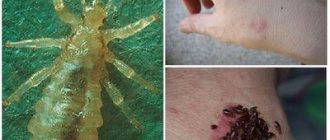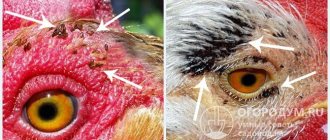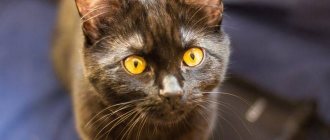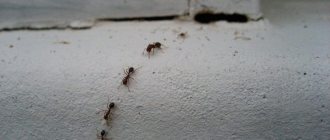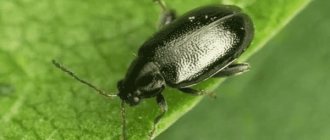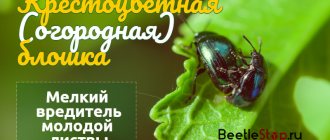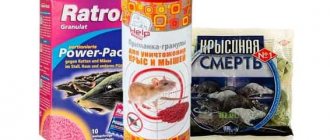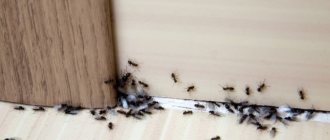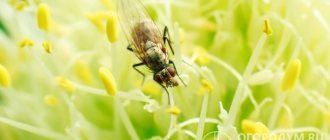Home » Useful information » Diseases and pests
Olga Polyakova 03/17/2020
9232 Views 3 comments
Fleas are parasitic insects that live in the fur or hair of mammals, or in the feathers of birds. They feed on the blood of their owners. In addition to the consequences of bites that cause discomfort and local inflammation, fleas are carriers of many dangerous diseases.
Humans have common diseases with some types of cattle (for example, pigs), as well as with almost all rodents. We do not come into direct contact with rodents, but we do this indirectly through predators - cats and dogs.
The list of diseases transmitted by fleas is quite extensive: from plague and typhus, which are considered deadly, to banal hepatitis, which, although not fatal, is quite unpleasant.
Separately, it should be said about allergies to flea saliva, which even in small quantities causes a very strong reaction. Therefore, if these insects appear in the house, they need to be neutralized as soon as possible - destroyed or expelled. The article discusses ways to get rid of fleas in a house or apartment.
Source of appearance in the house
Life cycle of fleas
There are relatively few ways for these harmful arthropods to enter your home. Mostly these methods are associated with living creatures inhabiting the surroundings of the house.
Sources of fleas in the house can be:
Pets
Cats and dogs carry fleas
The most common way for fleas to enter a house or apartment. Cats or dogs are the main carriers of fleas in a person's immediate environment. Actually, if an animal goes out for a walk in warm weather, it will almost always be attacked by fleas.
Fleas, temporarily deprived of a host, climb onto plants or simply tall objects and wait for a living creature to pass by them, after which they jump onto its fur.
Even if the animal is treated with flea treatment, the insect may remain on it for quite a long time before leaving it. Often the process of “leaving” is carried out already in the owner’s apartment.
Items of clothing and footwear
Clothing or shoes can be a source of fleas
Fleas can also travel on the human body. In the end, they may simply make a mistake in determining the type of living creature they have moved onto. The insect will look for a food source for some time, and, not finding it, they will also leave the item of clothing, but who can guarantee that this will be done on the street?
Also, flea eggs from the same animals encountered on the street or somewhere else can get on shoes or clothes.
Utility premises
Rodents living in basements are a source of flea spread
Each house has an attic and a basement, or, in extreme cases, an underground floor. The main carriers of most fleas - rats or mice - can live in such places. With sufficiently large populations of these rodents, there will also be a lot of fleas.
Typically, mass migrations of fleas occur after the death of the carrier, and the mortality rate among mice and rats is quite high. And every day hundreds of insects can lose their owners and go in search of new ones.
The small size of fleas allows them to get into any holes and cracks in walls, doors and floors, thereby appearing in seemingly absolutely incredible places.
Human factor
Fleas are blood-sucking insects
People can also act as carriers of fleas, and not always temporarily. Even wealthy representatives of the species Homo sapiens, who observe the rules of hygiene and carry out flea prevention in their homes, are not immune from becoming their carriers.
Given the small size of insects, as well as their active lifestyle, sometimes even their detection on the human body can occur several days or even weeks after infection.
What can we say about those cases when hygiene rules are not followed. Neighbors are not chosen, and if there is a dysfunctional tenant living in the building whose apartment is infested with fleas due to unsanitary conditions, there is a high probability that about a third of the residents of this building will also get unpleasant “tenants.”
Where and how do insects get into an apartment?
Knowing the characteristics of your residence and habitat, it is easy to guess where fleas come from in an apartment, even if there are no animals. Unfortunately, the absence of furry pets does not eliminate the possibility of infestation of the premises with parasites. Besides your four-legged friends who are often outdoors, fleas can appear in two other ways.
- "Neighbourly." Neighbors may have animals and excellent conditions for fleas. Parasites easily cross thresholds, are transferred from clothing to clothing, and travel on shoes. Simple friendly communication with neighbors on the landing can turn into an invasion of parasites.
- Damp basement. In the basements of apartment buildings, as a rule, it is warm and cozy for the reproduction of various living creatures, in particular rats. Fleas live on animals and they also thrive in such conditions. From the basement, through small cracks in the floor, insects can visit the residents of the lower floors. Owners living under the roof are also not protected from insects; parasites can “move” from the attic.
It is necessary to act immediately to prevent the proliferation of fleas. Insects lay hundreds of eggs, from which numerous parasites emerge. Even if all the adult individuals are exterminated, larvae and eggs may remain in the apartment, due to which the house will have to be treated again.
Mandatory events
Tar soap for fleas
Removing fleas that have become firmly established in an apartment or house is quite problematic, but it is still possible. The difficulties in dealing with them lie, first of all, in their small size, ability to go without food for a long time and very high fertility.
Fleas can literally wait out unpleasant times for months, and then come out of hiding and begin hunting for warm-blooded animals.
Therefore, the most important weapon in the fight against fleas is consistency. Only regular and constant repetition of operations for the prevention and destruction of insects can give a positive result.
It is recommended to carry out regular weekend activities to coincide with other hygiene procedures in the home.
Let's look at the list of activities that need to be carried out regularly to combat fleas:
Pet treatment
Applying flea drops to the dog's withers
Actually, this is where it all begins. The dog or cat should be washed with anti-flea shampoo and treat the animal's skin with a special anti-flea product (for example, drops).
The next stage is that all objects and things with which the animal constantly comes into contact should be put into a washing machine and washed at a temperature of at least +60°C.
These things may include:
- sheets and blankets
- pet bed
- his pillows and toys
Those items that are too large in size must first be dried in the Sun and treated using a steam generator or any type of cleaning. As a last resort, simply immerse it in a large container of water in which anti-flea shampoo is dissolved (for example, a bathtub).
If your pet has fleas, there is a high chance that he is also infected with parasites, since insects carry a significant number of helminths. In any case, it is recommended to consult a veterinarian for advice and possible treatment of the animal.
Processing of interior items
Carpet treatment
Carpets and furniture in the apartment must be cleaned. Fleas can be found in a fairly small space - no more than 1 m from the floor, therefore, everything that enters this space needs to be cleaned and treated with special means.
These can be various anti-flea drugs - powders or aerosols.
The following interior items are subject to treatment:
- carpets on the floor and located in the “risk zone”
- soft upholstery of chairs and sofas
- rugs in front of the front door
- rugs in the toilet and bathroom
First, they are processed using a vacuum cleaner (followed by immediate disposal of the contents of the dust container), then using chemicals.
Mopping floors
Floor disinfection is an essential part of the fight against fleas in the house.
Often fleas not only live in small defects in the flooring, but also leave their eggs there. It is necessary to regularly wash the floors with any antiseptic. These can be either special anti-flea products or a simple solution of bleach in water.
When washing floors, you should also treat baseboards, furniture legs, door openings, etc.
Destruction of potential habitats
Destruction of fleas in the apartment
Various items of clothing, shoes, and interior decoration located in the house may already be hopelessly damaged by fleas and cannot be subject to any type of cleaning or restoration. Such items may include old items stored in closets, mattresses, pillows, etc.
If traces of fleas are found on them, it is better to simply throw away such items without hesitation.
Regular cleaning of street clothes and shoes
Outdoor clothing and shoes can become carriers of fleas, so you should carefully treat them after each walk. Shoes need to be washed, and clothes (at least outer ones) need to be washed more often than usual.
What danger does it pose to people: bites and consequences
Most often, such insects live in the ground, in the soil or on various leafy plants. They do not pose a direct danger to human health, but they can carry various bacteria, viruses and microbes on their paws. Most of all, they harm crops, seedlings grown on a windowsill or indoor flowers.
In residential premises where people live, they can often be seen in private houses, cottages, and country houses. Most rarely - in apartments, and even then, they usually breed in old apartment buildings.
They enter the premises riding on pets, or along with bags, vegetables brought from the market, soil for planting flowers in pots, and also from dirty basements. As soon as these “guests” appear in the house, they immediately begin to settle in carpets, paths, in cracks in the floor and walls, and hide under baseboards. A little later you can already see them in upholstered furniture, in woolen clothes that no one has used for a long time. It should be noted that, despite the fact that the bugs are not bloodsuckers, they can still bite if they come into contact with human skin, but rarely.
The main danger to humans is the risk of an allergic reaction to flea bites, as well as infection or parasites. At the same time, they choose their victims quite meticulously, so many are concerned about the question of why earth fleas do not bite all people. There are several theories on this matter, each of which is quite logical and confirmed by practical research.
Why fleas don't bite everyone
- Many bloodsucking insects prefer a certain blood type and Rh factor (most often this is the first positive).
- Thin skin also attracts pests because it is much easier to bite through. That is why women and children most often become victims, while the head of the family can be completely invulnerable to bites.
- Ground fleas, like many other insects, also search for prey by the smell of sweat and temperature.
- There is an unconfirmed theory that blood-sucking insects prefer people with natural red hair. This theory may be true, but only due to the already mentioned point about thin skin, because this is one of the characteristics of red-haired people.
- In fact, fleas bite everyone indiscriminately, but the reaction to bites varies from person to person. Perhaps one of the most logical statements. In a room infested with these pests, by default there cannot be people completely immune to their attacks.
It should be noted that even a person with “tasteless” blood also runs the risk of receiving a lot of attention from earthen fleas. This can happen in the absence of certain gastronomic interests of insects, in excessively proliferated offspring, and also during a period when there is no alternative source of food. In any case, this situation should be stopped, and for this you need to know what to do if fleas bite and how to properly treat the bites.
Photos and symptoms of bites
The bites of these small insects are extremely painful and cause a rather “violent” reaction from the body. Even compared to mosquitoes, flea bites are more itchy and inflamed. In addition, if you are “lucky” with individual intolerance, this can become a real problem and develop into serious health complications. A flea bite can be identified by its characteristic symptoms: small randomly located dots, severe itching, close proximity of damaged areas. Even one individual usually leaves several bites on the body at a time, searching for vessels close to the surface, or moving during human movements.
You can take a closer look at the characteristic bites of the flea in the photo.
If you have been bitten by earth fleas, you need to know what to do in such cases. The bites are accompanied by severe itching, so the victim often scratches them. Red spots and even blisters may appear at this site; cases of severe allergies to substances injected under the skin are known. They not only prevent blood clotting, but also soften skin tissue. For the parasite, this makes it easier to eat; for humans, it becomes an additional threat of infection after scratching or exposure to pathogenic strains of bacteria from the outside. In addition, insects themselves can become carriers of certain types of parasites and infectious diseases.
What to do if you find bites
- Apply ice, a cold compress, or even a regular metal spoon to the bite site.
- Be sure to disinfect the damaged area to prevent suppuration.
- From folk recipes, you can use honey, soda, apple cider vinegar (diluted in half with water), a slice of lemon or chopped fresh parsley (can be replaced with plantain).
The pharmacy also has many drugs suitable for such cases. Steroids and antihistamines, which are used to prevent an allergic reaction, require consultation with your doctor. First aid medications, which also work well against insect bites, can be used as needed. These include gel “Fenistil”, “Rescuer”, sulfur ointment, “Flucinar” or “Elidel”. They are sold over the counter and help relieve itching and inflammation of the skin. However, if you have a strong negative reaction, you should definitely see a doctor for further treatment.
Effective chemicals against fleas
Flea sprays
The listed treatment methods will require the use of various chemicals to kill fleas. These products contain various types of insecticides, differing in varying degrees of effectiveness and safety for humans and animals.
Thanks to advances in the chemical industry, there are now several dozen products that can effectively kill fleas, ticks, bedbugs and other insects. It is quite problematic to give a specific recommendation on the use of this or that product (due to their large number).
The most effective are products containing broad-spectrum nerve or complex insecticides. They destroy the chitinous shell of the insect and affect its nervous system, causing paralysis and death.
Currently, the most effective products are those containing the following substances:
1 Pyrethrins , which are natural insecticides with nervous action. They have average effectiveness, but are safest for mammals. It is with their help that animals are processed
2 Pyrethroids are more effective substances related to pesticides. They are of artificial origin and also affect the nervous system of insects
Deltsid in ampoules for treating apartments against fleas
Animals should not be treated with pyrethroids! Moreover, it is advisable to remove animals from the premises while the premises are being treated.
One of the popular pyrethroids is imidacloprid.
3 Nitenpyram . A drug used for internal use. Safe for people and animals, capable of killing parasites within one hour. The form of release can be very diverse. However, not all animals can be fed this drug.
4 Selamectin . A weaker internal insecticide. Suitable for puppies and kittens
5 Finiprol is a drug in the form of drops used to treat animal hair
When purchasing one or another anti-flea product, you should look for the listed drugs in its composition , since they are the ones that are quite effective.
Ground fleas in the yard
Persistent bugs can enter the premises from the yard of a private house. If in high-rise buildings the risk of injury is relatively small, for owners of their own houses it increases significantly. How to deal with earthen fleas in the yard, since they can independently penetrate into a living space, without even bothering to look for “intermediaries”? You will have to act quickly and purposefully, because not only your home plants are at risk, but also your loved ones. To do this, there are special preparations that need to be used to treat the garden, yard and the area immediately adjacent to the house. It is dangerous to use kerosene, turpentine and other substances. In addition to the immediate threat of fire and the characteristic odor, the risk lies in soil contamination and its unsuitability for further growing plants.
Folk remedies against fleas
Folk remedies against fleas
Despite the abundance of chemicals, a large number of people do not use them very often, and the reason for this is understandable. Whatever the manufacturer’s assurances about the safety of a particular product, they are all poisons to varying degrees and can cause, if not poisoning, then quite serious allergic reactions.
An alternative to the use of chemicals is the use of folk remedies that have been proven for centuries. Undoubtedly, their effectiveness in the medium term is somewhat lower than specialized drugs, but their negative effects have practically no consequences for human health.
Most of these products are of plant origin. Let's take a closer look at folk remedies against fleas.
Sagebrush
Wormwood is a natural flea repellent
One of the most common plants used against fleas. Wormwood contains aromatic oils that have a pungent odor that repels fleas and other insects.
Dried wormwood is laid out in places where fleas may enter or live, and often the floor surface is simply covered with it.
Wormwood does not destroy, but simply repels fleas, so its use is more of a preventive nature.
Persian chamomile
Persian chamomile or peretrum contains a natural insecticide
A more effective product that contains natural insecticides – pyrethrins. The stems and leaves of the plant can not only repel, but also kill fleas.
The disadvantages of using Persian chamomile include the fact that in order to effectively kill insects, the material must be sufficient and fresh, since pyrethrins decompose relatively quickly.
The application is similar to the use of wormwood - the stems and leaves are scattered on the floor and remain on it for 24 hours. After a few days the process is repeated.
Application of infusions
Wormwood to fight parasites
Infusions and decoctions of several components, which have both a repellent and insecticidal effect, have proven themselves well.
For example, concentrated infusions consisting of the following plants work well against fleas:
- wormwood
- eucalyptus
- tansy
- mint
Mixtures of several infusions are also often used. Decoctions and infusions made from pine sawdust have a good repellent effect.
The use of such products consists of treating all surfaces in the apartment located at a height of no more than 1 m from the floor. The treatment is repeated every 2-3 days.
Powders, dusts, crayons
Powders for fleas and their larvae
Dusts are all products in the form of bulk powders. Preparations in powder form that require dilution with water are often included in this category, such as Super Fas. Dusts are packaged in spray bags. Before use, holes are made in the indicated places, after which the product is applied along baseboards, in waste storage areas, and on furniture.
On a note!
Dusts are ineffective against adult insects, since in order for them to be effective, the insect must come into contact with the drug. Given the mobility of fleas, it is not possible to spray the product over the entire area of a residential apartment.
However, in relation to crawling worm-like larvae, the use of dusts is completely justified. There is a wide range of bulk products on store shelves:
- Fas Double is a flea powder based on two insecticides: deltamethrin and fenthion. The action of the active components lasts for 2 weeks. Used dry. The price of one package is 20 rubles. Another product from the same manufacturer is Super Fas. Before use, the powder is diluted with water in accordance with the instructions and the apartment is treated with a brush or spray bottle. The cost in online stores is 60 rubles.
- Tornado - active ingredients: cypermethrin and boric acid. Helps fight all annoying synanthropic insects. The price does not exceed 30 rubles.
- Phenaxin is a powder costing 45 rubles, which contains fenvalervate, boric acid and oil, which improves the adhesion of the substance to the paws of pests. Valid for 30 days. cannot be used near aquariums.
- Clean house. The multicomponent composition is represented by boric acid, cypermethrin, tetramethrin, malathion, pyrethrum. One package is enough to process 12 square meters. m. Estimated price 40 rubles.
On a note!
Chalks have a similar effect to dusts, the most famous of which is Mashenka. However, you should not rely on its high effectiveness against fleas. Its use is more appropriate for prevention purposes. Draw chalk lines along the baseboards, the front door - places where insects can enter.
Pyrethrum powder for fleas deserves special attention. It is made from Dalmatian chamomile inflorescences. Products based on it are safe for children and other household members. It has a light floral aroma; when the parasite comes into contact with the powder, the functioning of the nervous system is disrupted, which invariably leads to the death of the insect. 6 tablespoons of pyrethrum are combined with a liter of water and the apartment is treated using a spray bottle. There is no need to isolate household members and pets during the procedure; disinfestation with Dalmatian chamomile can be carried out in their presence.
Review
Pyrethrum powder helped get rid of fleas in the apartment. I liked the lack of a toxic smell and the ability to use it when there are small children in the house.
Alexey, Boguchary
Methods for controlling earthen fleas
If fleas are found in the room, you need to act immediately. Special chemical preparations against insects and folk remedies that are safer for others will come to the rescue. The latter are not so effective, but for prevention and as auxiliary ones they are quite useful.
It is important to re-treat the room. The fact is that it is not always possible to get rid of parasites the first time. The most difficult eggs to destroy are those that are laid in inaccessible places. After some time, they hatch into larvae that turn into fleas. Therefore, it is recommended to treat housing 3 times at weekly intervals.
So, in order to remove parasites once and for all, you need to act comprehensively:
- Remove fleas from the basement of the house. If this is an apartment building, then you need to agree with the neighbors about joint “harassment”.
- Eliminate the causes of dampness in the basement, replace pipes if they are leaking.
- Treat the entrance and staircase.
- Throw away old entry mats.
- If there is a cat or dog in the house, then it is advisable to also throw away the lounger on which the animal sleeps.
- Treat pets against parasites.
- Vacuum the apartment well, paying special attention to corners and hard-to-reach places, as well as upholstered furniture and mattresses on all sides. Also, take the time to move the sofa and clean under it.
- Take all carpets outside, beat them well and leave them to air. Do the same with blankets and pillows.
- Treat rooms (furniture, curtains, tulle) and outdoor carpets with insecticidal preparations.
- Wash clothes, bed linen, and other textiles (if the fabric allows such treatment) at the maximum allowed temperature.
- Re-treat the room after a week.
- Take preventive measures to avoid the reappearance of parasites.
Upholstered furniture, mattresses, carpets, curtains are treated with products that are harmless to humans and animals. The floor and all hard washable surfaces can be treated with more toxic preparations.
Pay special attention to the bathroom. Under the bathroom, where it is dark, damp and warm all year round, fleas feel especially good.
To eliminate any possibility of parasites independently entering the house, my friend took serious preventive measures. He caulked all the cracks in the floor and under the baseboards, and laid insulation around the perimeter of the front door. Thus, he blocked all “access” routes for fleas. After this, they will be able to enter the apartment only through an open door or with shoes and outerwear.
You can purchase a steam mop. It will allow you to treat upholstered furniture, mattresses, carpets, etc. with hot steam. Fleas cannot tolerate high temperatures.
Pets can be treated several times (with an acceptable interval to avoid poisoning) with anti-flea preparations for animals: shampoos, aerosols, drops. You can buy them at a veterinary pharmacy or pet store. Don't forget about a special collar. This will provide your pet with additional protection from parasites.
You can also contact a special insect control service. Professionals, using effective and safe means, will help cope with the “flea infestation” for a long time.
There are many ways to control basement fleas
Getting rid of fleas with chemicals
All chemical insecticides can be divided into three groups:
- powders;
- aerosols;
- liquids (sold in ampoules).
It is most convenient to use aerosols, since they can be used to treat even secluded places. Walls should be sprayed at a level of 1–1.5 m. Fleas do not climb higher.
The shelves in the lower kitchen cabinets and the space behind them need to be carefully treated.
Powders are scattered throughout the room, and liquid poisons are first dissolved in water, and then floors, furniture, window sills and walls are washed with this liquid.
When choosing an insecticide, be sure to see if it is labeled “for crawling insects.” This remedy will be most effective.
Insecticidal powder
Powders are good because they stick to the legs of insects, due to which they are spread throughout all the cracks. Processing is carried out as follows:
- Vacuum the room.
- Wash the floor, paying special attention to corners and baseboards.
It is very important to carry out wet cleaning after treatment. - Pour the powder into all the cracks in the house.
- Use a putty knife or cardboard to fill the space under the baseboards.
- Make sure that the product is under the furniture and in all the nooks and crannies of your home.
The fleas will spread the insecticidal powder to all their shelters and deliver it to the larvae - The next day, vacuum the room and do a wet cleaning.
The duration of action of different drugs may vary. It is advisable not to clean your home until the parasites are completely destroyed. If the drug is toxic to people and animals, then it is better to leave the house for the duration of its effect.
Aerosol
You can use either a purchased insecticide in an aerosol or prepare your own from the preparations in ampoules. On average, 10 ml of product is required per 1 m2 of surface.
Step-by-step instruction:
- Carefully carry out dry and wet treatment of the room.
- Spray all cracks, joints and gaps under the baseboards.
It is important to treat the baseboards - a huge number of parasites are hidden under them - Don't ignore hard-to-reach places such as corners and the floor under furniture.
- If the rooms are covered with linoleum, then pay attention to the places where it lags behind the floor.
- Treat the bottom of upholstered furniture, curtains, carpets, top and bottom runners, window sills and walls.
- After a few hours, ventilate your home.
- Vacuum the area to remove the bodies of dead insects and larvae, and wash previously treated areas to remove the toxic substance.
It is important to thoroughly wash the floor and previously treated areas with insecticides. - Re-treat the area after a week.
After spraying a room, it is important to keep windows and doors closed for 2-3 hours. Limiting the free access of air from the street helps to more effectively kill fleas.
Carrying out wet treatment with insecticide
You will need ampoules to prepare an insecticidal solution. To fight fleas you need:
- Clean the premises.
- Dilute the contents of the ampoules in the required amount of water (usually take 1 ampoule per 1 liter of water).
One ampoule of insecticide is diluted in 1 liter of water - Moisten a rag in the resulting solution and thoroughly clean the room: floor, joints, window sills, front door, etc.
- Pour a little solution into a spray bottle and treat the walls and everything that cannot be washed (furniture, mattresses, carpets).
The insecticide solution can be used to spray walls and upholstered furniture - Repeat treatment according to the instructions on the product packaging.
- Carry out dry and wet cleaning of the room after the insecticide has expired.
Chemicals for fighting earth fleas
Insecticidal preparations may differ in active ingredients. The most common of them are:
- preparations based on dichlorvos. To make the treatment as effective as possible, it is carried out at least twice. Dichlorvos affects the nervous system of the insect and causes paralysis, as a result of which it dies. May be dangerous to animals and people;
- preparations containing pyrethroids, pyrethrins. These are substances that have a fatal effect on the nervous system, provide a long-lasting effect, but have a negative effect on animals. It is better to use them only on washable surfaces;
- fipronils. They have a paralyzing effect on the nervous system and are safe for animals and people;
- imidacloprids (neonicotinoids). Safe for warm-blooded creatures, but effective against crawling insects.
The most popular chemicals are the following:
- "Raptor", "Raid". Easy-to-use aerosols, safe for children and animals;
- “Get” - the product has a pleasant smell and does not spoil the surface of furniture, including varnished furniture. But it is not advisable to use it if there are pregnant women and children in the house;
- "Combat" is an insecticide with contact-intestinal action. Sold in ampoules and aerosol form. It has an unpleasant odor and is harmful to furniture coverings, but has low toxicity for people and animals. Safety measures: ventilation and thorough wet cleaning;
- Dichlorvos is a proven product that can be purchased in aerosol form. Modern drugs have low toxicity to humans, but it is still necessary to ventilate the room for a long time after treatment;
- Neostomazan disinfectant solution. Release form: ampoules. Harmless to all warm-blooded creatures.
For maximum effectiveness of drugs, when making solutions, you need to use water without chlorine (purified or settled). Chlorine interacts with the active substances of insecticides and weakens their effect.
You can also find powders on sale: “Clean House”, “Pyrethrum”, “Finaxin”, etc. They are less effective, do not affect eggs, but are able to cope with parasites with a slight infection. In the fight against earthen fleas, remedies for ants and Colorado potato beetles have proven themselves well.
There are also special preparations that are distributed throughout the room in the form of steam. But they are ineffective compared to aerosols and powders.
Insecticide "Raptor" spreads in the form of steam throughout the room
Folk methods of struggle
Traditional methods are safer than chemical ones, but are significantly less effective. Some products act solely as repellents, while others can destroy insects and larvae.
Repelling with plants
Fleas cannot tolerate the smell of wormwood, tansy and Damask chamomile. Fresh stems with leaves and flowers are laid out in problem areas. Every two days, wilted plants are replaced with fresh ones. The method is effective, although it will not be possible to destroy pests and their offspring.
In the same way, you can use pine sawdust, orange and lemon zest, strong-smelling spices, and garlic.
Ground fleas cannot stand the smell of cedar
Wormwood tincture
The finished concentrated infusion is sold at the pharmacy. You can also prepare it yourself:
- Pour water into the pan and bring to a boil.
- Add a handful of chopped herbs and boil for a minute.
- Turn off the heat and let the liquid cool.
- Leave for 4-5 hours and then strain through a sieve.
- Dilute the finished infusion in clean water at a rate of 2 tbsp. l. for 1 tbsp. water.
- Pour the solution into a spray bottle and treat your favorite flea spots in the house.
- Repeat the procedure after a week.
In the same way, you can prepare infusions of tansy, eucalyptus leaves, and Damask chamomile.
For preventive purposes, it is recommended to spray the room every 7 days.
Tansy infusion is considered one of the most effective folk remedies for fleas
A mixture of soda and salt
Another popular remedy is a mixture of baking soda and kitchen salt. The processing process is as follows:
- Mix salt and soda in equal quantities (1:1).
- Sprinkle in the corners of the house, near baseboards and the front door.
- Leave it overnight, or better yet, for several days.
- Collect with a vacuum cleaner.
Baking soda and salt are often used to repel crawling insects
Ammonia
Nobody likes the smell of ammonia, so this remedy is often used in the fight against insects. Add 1 tsp to the washing water. ammonia per 1 liter of water. The floor and walls are washed with the solution. You can pour the product into a spray bottle and spray surfaces, including visible parasites.
Essential oils
To combat earth fleas, essential oils of eucalyptus, geranium, cedar, clove and mint are most often used. They are added to water for washing, making sprays, and also used in their pure form:
- for wet cleaning, add 5-10 drops of oil to a bucket of water. It is advisable to carry out this procedure at least 2 times a week;
- for preparing spray for 1 tbsp. water you will need 3-5 drops of oil. Shake the bottle well, and then treat cracks, joints and other places in the house;
- To use in its pure form, a few drops of oil are applied to napkins or cotton pads, and then the latter are laid out under furniture, in corners, near the front door, etc.
A friend of mine prepares a spray with essential oils of eucalyptus and mint to prevent the reappearance of fleas. He treats all problem areas in the apartment 1-2 times a week. He says that he even began to get sick less, since these oils can kill germs.
This method is safe for animals and children, but there is still a risk of allergic reactions.
With the help of essential oils you can protect your home from repeated penetration of parasites
Brewer's yeast with garlic
Brewer's yeast is mixed with chopped garlic in equal proportions. This paste is used to treat problem areas in an apartment or house. After drying, the product is collected with a vacuum cleaner. The smell of garlic combined with yeast acts as a powerful repeller for any insects in the house, but it can also be unpleasant for all family members.
The smell of garlic repels fleas and other insects
Borax, botanical dust
These are relatively safe insecticides that have a destructive effect. They are used as follows:
- Pre-clean the room.
- Scatter the powders in all “flea” areas and leave overnight.
- Collect with a vacuum cleaner and carry out wet cleaning (you can use ammonia or essential oils).
It is better for pregnant women, children, and pets to leave the premises during treatment.
Boric acid can kill both adults and larvae
Kerosene
Kerosene has a strong, unpleasant odor. It is used in diluted form for washing floors and treating carpets. A bucket of water will require 50 g of kerosene. When treating problem areas, you can make more concentrated solutions (1:1).
Kerosene is a highly flammable substance. Smoking is prohibited in the processing area.
Video: folk methods of fighting earth fleas in the house
Safety precautions when removing fleas
Since most insecticides are toxic and can harm the human body, you should not neglect the means of protection. You will need:
- respirator, gauze bandage;
- protective glasses;
- latex gloves.
Do not forget to ventilate the room after treatment for several hours. It would be ideal if you can leave the house for 1-2 days during the treatment.
Gloves and a mask are reliable protection when working with chemicals
If there are children or pregnant women in the house
Small children crawl around the apartment, touch everything with their hands, and then put their fingers in their mouths. Pregnant women inhale harmful fumes, which can negatively affect the development of the fetus. In such cases, you can use only completely safe products. These are the same folk remedies, with the exception of boric acid, botanical dust and kerosene (its smell can cause nausea in pregnant women) or based on neonicotinoids, neostomazan (look on the package). Children and pregnant women must leave the house during chemical treatment. After the procedure, a thorough wet cleaning is carried out and the room is ventilated for a long time.
If there are animals in the house
It is not advisable for pets and birds to be in the house during treatment. If there is nowhere to put them, then it is recommended to use only those products that are sold in a veterinary pharmacy and are safe for animals, for example, drugs with the active ingredients fipronil, neonicotinoids, neostomazan.
